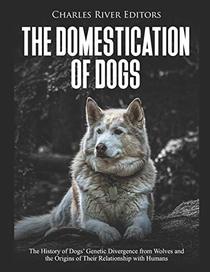There's a lot to like about this book. The photos are beautiful and the text is very interesting. It shows how dogs changed from being a predator to being a companion. Over the generations, dogs have become seeing-eye dogs, police partners, and weapon warriors. But how did the amazing fusion of man-and-his-dog emerge?
Miacis (a long-dead animal genus) roamed the earth about 60 million years ago. That beast was four-legged and weasel-like, with small brains. But about 30 million years ago, the Leptocyon genus (the first true canines) looked more like foxes. Twenty million years ago, the Mesocyon coryphaeus (the short-faced dog) arrived on the scene. Only 7 million years ago, the wolves arrived. They were called the dire wolf and were the ancestors of the present-day gray wolves.
Around 750,000 years ago, the dire wolves migrated around the world. In 1997, DNA proved that all dogs today emerged from domesticated wolves. That means that they are not directly related to jackals, coyotes, dingoes, etc. Researchers also proved that nomadic hunter-gatherers domesticated the wolves. Some researchers now think that dogs have been domesticated for about 36,000 years. The explanation of 'village dogs' is very interesting.
There are two theories about who domesticated whom; some say that man trained some wolves to be subservient, while others say that wolves decided to follow people. However, it happened, it took 10 generations of constant people-dog interactions for the learned behaviors to be converted to genetic traits.
Once the book forked away from the genetic history of dogs to how people used dogs through the ages, the story became less interesting. However, the info about the Colonial 'dog-snobs' who wouldn't allow their prized pets to mate with native dog populations (which caused the indigenous breeds to die out) is fascinating. Be sure to take a look at the 19th century Hare Indian Dog, that is one of the extinct dog varieties that roamed the US in its earlier days. I read this book in one sitting because the subject was so interesting and engaging.
Miacis (a long-dead animal genus) roamed the earth about 60 million years ago. That beast was four-legged and weasel-like, with small brains. But about 30 million years ago, the Leptocyon genus (the first true canines) looked more like foxes. Twenty million years ago, the Mesocyon coryphaeus (the short-faced dog) arrived on the scene. Only 7 million years ago, the wolves arrived. They were called the dire wolf and were the ancestors of the present-day gray wolves.
Around 750,000 years ago, the dire wolves migrated around the world. In 1997, DNA proved that all dogs today emerged from domesticated wolves. That means that they are not directly related to jackals, coyotes, dingoes, etc. Researchers also proved that nomadic hunter-gatherers domesticated the wolves. Some researchers now think that dogs have been domesticated for about 36,000 years. The explanation of 'village dogs' is very interesting.
There are two theories about who domesticated whom; some say that man trained some wolves to be subservient, while others say that wolves decided to follow people. However, it happened, it took 10 generations of constant people-dog interactions for the learned behaviors to be converted to genetic traits.
Once the book forked away from the genetic history of dogs to how people used dogs through the ages, the story became less interesting. However, the info about the Colonial 'dog-snobs' who wouldn't allow their prized pets to mate with native dog populations (which caused the indigenous breeds to die out) is fascinating. Be sure to take a look at the 19th century Hare Indian Dog, that is one of the extinct dog varieties that roamed the US in its earlier days. I read this book in one sitting because the subject was so interesting and engaging.




